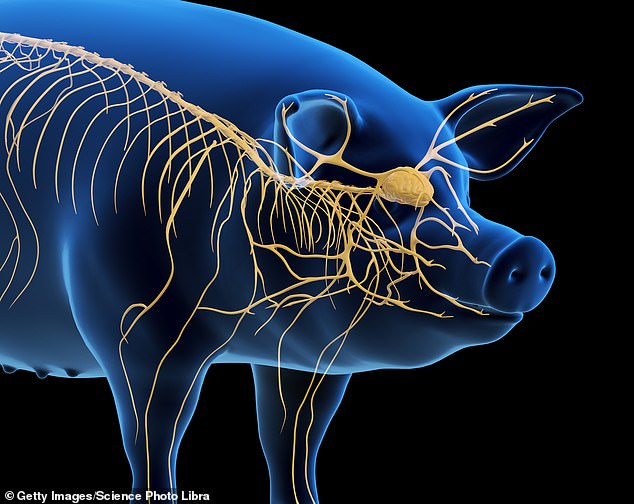It might sound like something straight out of Frankenstein’s lab.
But Chinese researchers have now managed to revive a pig’s brain, one hour after it was removed from the body.
Scientists from the Guangdong Provincial International Cooperation Base of Science and Technology were able to restore brainwaves ‘considered to represent conscious activity’ in the brain of a dead pig using an unusual new method.
The technique works by incorporating a healthy liver into the artificial life support system keeping the brain alive.
It is believed that the liver produces back-up energy molecules called ‘ketone bodies’ which protect the brain from injury.
While the technique has only been used in pigs so far, the researchers say it could be used in humans in the near future.
The researchers suggest that heart attack patients could be resuscitated by hooking them up to gene-edited pig livers.

A team of Chinese scientists has managed to revive a pig’s brain up to an hour after it was removed from the body using a new life-support technique (stock image)
When the body enters cardiac arrest and the heart stops beating, one of the most damaging things that can happen is that the organs are starved of oxygen and energy.
In the absence of any blood circulation, the cells which make up important tissues soon begin to die.
This process, called ischemia, can cause irreparable brain damage within minutes, leading to life-long health complications or death.
However, looking at hospital data for cardiac arrest patients, the researchers noticed a surprising pattern.
Patients who also suffered ischemia of the liver tended to experience worse neurological damage, stayed in the ICU for longer, and had higher mortality rates.
Those whose livers remained healthy, on the other hand, tended to survive much longer and had better health outcomes.
From this, the researchers hypothesise that there might be some connection between the function of the liver and the way the brain reacts to cardiac arrest.
To test this theory, the researchers artificially induced ischemia in 17 lab-raised Tibetan minipigs.


The researchers theorised that the liver was somehow connected to the brain during cardiac arrest. They found that Tibetan minipigs (pictured) suffered less brain damage during a simulated heart attack if the liver was left intact (illustrated right)
One group had blood flow restricted only to the brain, a second also had circulation cut off to the liver, while a third was left as a control.
When the pigs’ brains were removed and dissected, the researchers found that those who had not experienced liver ischemia suffered significantly less brain damage.
Putting these ideas into practice, the researchers set out to develop a life-support system which could incorporate a healthy liver.
Typically, a basic life support system consists of an artificial heart and lungs and is used to pump fresh oxygenated blood to the brain.
This technique, called extracorporeal membrane oxygenation, bypasses the role of the heart and can keep a patient’s brain alive until normal cardiac activity is restored.
The researchers’ modified version, however, added a living liver into this circuit so that fresh blood was pumped through the organ before reaching the brain.
The brains of pigs were then removed and hooked up to either the basic life support system or the modified version including a liver.
First, the brains were left for 10 minutes before life support was turned on – to simulate a massive heart attack.

The brains were brought back to life using a modified life support system (pictured) which includes a live, healthy liver alongside an artificial heart and lungs. This system was able to bring a pig’s brain back to ‘conscious’ function for up to six hours, even after it had died for 50 minutes
In the system without the liver, brain activity returned within half an hour and persisted for three to four hours afterwards.
In brains hooked up to the liver, meanwhile, brain activity reemerged within an hour but lasted for the entirety of the six-hour observation period.
Pushing this further, the researchers then began extending how long the brains were left before turning on the life-support.
They found that the longest interval which showed serious promise of being revived was 50 minutes.
Brains left detached from the body for this length of time still produced alpha and beta waves, which indicate conscious activity for the full six hours after being kickstarted back to life.
Even brains which had been left for a full hour could be coaxed back into conscious activity, but this quickly faded after three hours.
While removing the brain obviously wouldn’t work for human patients, the researchers say these findings could help save lives.
By incorporating a healthy liver into the life support process, doctors might be able to extend the window in which patients can be revived.

The researchers say this technique could be used to extend the window in which human patients can be resuscitated. In the future cardiac arrest patients could be hooked up to livers from ‘gene edited minipigs’ (stock image)
This could either be done using an artificial liver or by hooking the patient up to another healthy liver.
The researchers even note that recent advances in ‘gene edited minipigs’ could provide a ‘timely organ supply’ for this treatment.
In their paper, published in EMBO Molecular Medicine, Dr Zhiyong Guo, of Sun-Yat-Sen Universtity, and his co-authors write: ‘These findings highlight potential therapeutic targets for intervention.’
This article was originally published by a www.dailymail.co.uk . Read the Original article here. .


